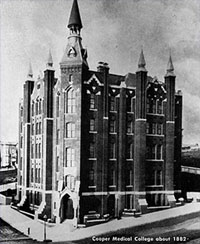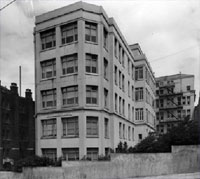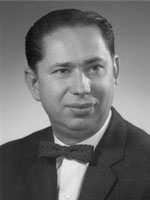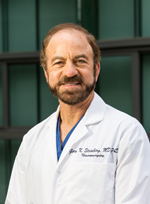Department History
 Stanford University School of Medicine –1908 (previously Cooper Medical College) |
In 1917 Stanford University Hospital in San Francisco opened its doors and in 1919 the Stanford Home for Convalescent Children was founded.
 Stanford University Hospital –1917 |
In 1942 Emile Holman, MD, Stanford University’s second Rhodes Scholar, graduate of Johns Hopkins Medical School, and current Chief of Surgery at Stanford Medical School, turned his private practice over to Dr. Reichert. Dr. Reichert was among a small group of neurosurgeons that included Howard Naffzinger, Chair of the Department of Surgery and Division of Neurosurgery at UCSF (also a Cushing trainee), to develop the neurosurgery field in Northern California in the early part of the 20th century.
The Hanbery Society (Click here for our new Hanbery site)
 John Hanbery, MD |
Five years later in 1959, and 41 years after its founding, the Stanford University School of Medicine moved from San Francisco to its new location on the Stanford University Campus as the Palo Alto-Stanford Medical Center Hospital (co-owned by the City of Palo Alto). That same year Dr. Hanbery temporally left full-time academia to join neurosurgeon Dr. James Golden at the Palo Alto Clinic. He remained on the Stanford teaching faculty, however, and in 1961 he returned to Stanford full-time as Clinical Professor of Neurosurgery, where he established the very first Stanford Neurosurgery Residency training program. In 1964 Roy Cohn, MD, Chair of Surgery, appointed Dr. Hanbery Professor and Head of the Division of Neurosurgery where he would remain until 1989.
John Hanbery was known as a consummate clinician, superb technical surgeon, and leader in the development of Spine Neurosurgery and Pediatric Neurosurgery. Most notable, however, was his devotion and loyalty to Neurosurgery residents. During his tenure he trained 26 residents in diagnostic acumen, surgical proficiency, clinical care, as well as compassionate bedside manner.
In 1974 former residents honored Dr. Hanbery by establishing the John W. Hanbery Neurosurgical Society, an organization of Stanford Resident Alumni and honored guest members that meet annually to present scientific and clinical papers.
Dr. Hanbery also recruited an illustrious group of Neurosurgery faculty who would become instrumental in creating the outstanding Neurosurgery program that exists today, including Gerald Silverberg (1973), Frances Conley (1975), Richard Britt (1977), Larry Shuer (1984), John Adler (1987), and our current Chair, Gary Steinberg (1987). Dr. Silverberg brought microscopic neurosurgery to Stanford and spearheaded the effort to obtain departmental status for Neurosurgery. Dr. Britt, who passed away in 1985, was the first neurosurgical faculty member to receive NIH funding. Dr. Adler’s invention of the CyberKnife completely changed the landscape in the neurosurgical treatment of brain tumors with his frameless and minimally invasive robotic system that targets radiation precisely to a tumor or vascular malformation without damaging nearby radiation-sensitive areas of the brain. Since 1994 over 4,500 patients at Stanford Hospital & Clinics and 70,000 worldwide have been treated with the CyberKnife. Dr. Shuer, former Chief of Staff at Stanford Hospital & Clinics, is the current Associate Dean for Graduate Medical Affairs.
 |
|
Gary K Steinberg, MD, PhD Bernard and Ronni Lacroute-William Randolph Hearst Professor of Neurosurgery and the Neurosciences Chairman, Department of Neurosurgery Appointment by courtesy, Neurology & Neurological Sciences |
In 1996 Gary Steinberg, MD, PhD, became Chair of the department and began an unprecedented expansion of our clinical and basic research programs. Today our department comprises 34 neurosurgeons and research faculty. Centers for stroke, brain tumors, cerebrovascular neurosurgery, epilepsy, functional neurosurgery, head and spine trauma, pediatric neurosurgery, and pituitary tumors treat many of the most severe pediatric and adult cases using state-of-the-art and minimally invasive diagnostic and surgical techniques. The number of surgical cases has more than tripled in the last 10 years, and Stanford Clinical Neurosciences is No. 1 in bay area neuroscience discharges and the No. 1 academic institution in the US for stroke management according to the University Health Consortium. In the past 10 years NIH and other extramural funding has grown more than 10 fold. In 2008 Stanford’s Department of Neurosurgery ranked 4th nationally in NIH funding, having gone from approximately $100,000 in 1996 to over $5 million in 2008 in total extramural funds. More than ever before, academic and clinical research combines scientists and clinicians across multiple disciplines, and numerous basic and translational clinical research efforts are currently underway.
Upcoming Stanford Hanbery Society Meeting
42nd Annual Meeting of the Stanford Hanbery Neurosurgical Society
Aug. 4-7, 2016
Carmel Valley, California
Our 42nd Annual Meeting will feature a robust scientific program, business meetings, and ample opportunities to connect. Check back soon for a full program.
To view last year's program, click here.
Interested in sponsorship? Learn more.
